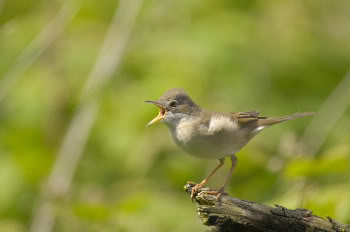|
|
Global warming is likely to increase the length of bird migrations, some of which already extend thousands of miles. The increased distance could imperil certain species, as it would require more energy reserves than may be available.
The new study, published in the Journal of Biogeography, studied the migration patterns of European Sylvia warblers from Africa to breeding grounds in Europe every spring. They discovered that climate change would likely push the breeding ranges of birds north, causing migrations to lengthen, in some cases by a total of 250 miles.
 According to a new study this singing common whitethroat’s migration is likely to lengthen from 3,417 miles to between 3,541-3,759 miles. Photo courtesy of RSPB. |
“Most warblers come [to the UK] in spring and summer time to take advantage of the surplus of insects, and leave for warmer climes in the autumn. From 2071 to 2100, nine out of the 17 species we looked at are projected to face longer migrations, particularly birds that cross the Sahara desert,” said Dr. Stephen Willis of Durham University. “Our findings show that marathon migrations for some birds are set to become even longer journeys. This is bad news for birds like the Whitethroat, a common farmland bird. The added distance is a considerable threat.”
In order to make migrations thousands of miles long, birds must put on significant amounts of weight in fat, with some species going so far as to double their weight. Other species even shrink the size of their internal organs to increase efficiency in flight.
“These tiny birds make amazing journeys, pushing themselves to the limits of endurance,” said paper co-author Professor Rhys Green of Cambridge University and RSPB. “Anything that makes those journeys longer or more dependent on rare and vulnerable pit-stop habitats used for refueling on migration could mean the difference between life and death.”
Some species have already been observed selecting new breeding grounds further north. A subpopulation of blackcap warblers have begun wintering in England instead of usual haunting grounds in the Mediterranean.
“The projected distances for migrations would require long and short distance fliers to increase their fuel loads by 9 per cent and 5 per cent of lean body mass respectively,” Nathalie Doswald, a student with the research team, noted. “The predicted future temperature changes and the associated changes in habitat could have serious consequences for many species.”
While Wallis believes that there may be ways for species to deal with the longer distances, he does not mince words about the challenges before migrants. “Some species may be able to adapt and change, for example by adopting shorter migration routes, if they can find enough food at the right time. Bird migrations are incredible feats of stamina and endurance but, as temperatures rise and habitats change, birds will face their biggest challenge since the Pleistocene era.”
Related articles
Fit with tiny backpacks, songbirds reveal speed of migration at 311 miles a day
(02/12/2009) Using extra tiny geo-locator backpacks, researchers have tracked songbirds’ seasonal migrations for the first time, according to research published in Science . The researchers discovered that these beloved birds fly faster and further than anyone ever imagined. The data taken from the geo-locators surprised everyone. Stutchbury and her team discovered that during their migrations between Pennsylvania and South America songbirds flew more than 311 miles a day, three times higher than previous estimates.
Global warming drives birds north
(02/11/2009) Nearly 60 percent of the 305 species found in North America in winter have shifted their ranges northward by an average of 35 miles, according to an assessment by the Audubon Society.
Global warming may doom emperor penguins to extinction
(01/27/2009) Disappearing sea ice around Antarctica may put emperor penguins at risk of extinction within the next century, warn scientists writing in this week’s Proceedings of the National Academy of Sciences.
52% of amphibians, 35% of birds at risk from climate change
(10/08/2008) 52 percent of the amphibians, 35 percent of birds and 71 percent of reef-building coral are “particularly susceptible” to climate change, warns an IUCN report.
Migratory waterbird populations in decline in Europe
(09/15/2008) 41 percent of 522 migratory waterbird populations on the routes across Africa and Eurasia show decreasing trends, reports a new study released at the African-Eurasian Migratory Waterbird Agreement meeting in Antananarivo, Madagascar.